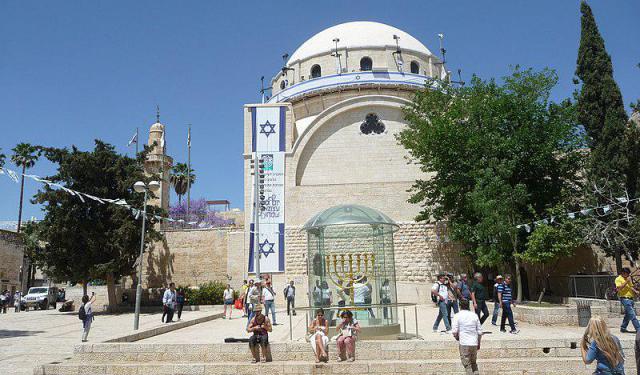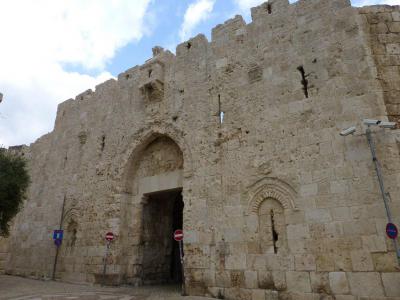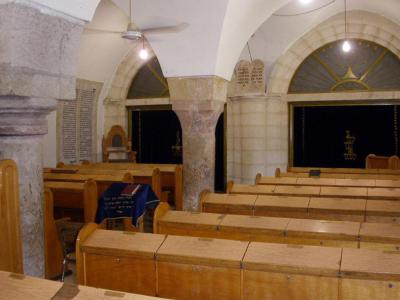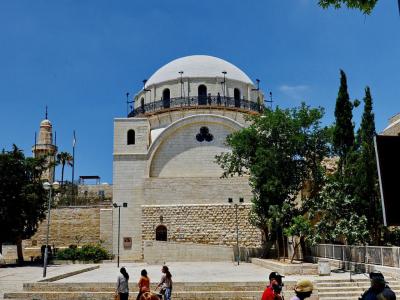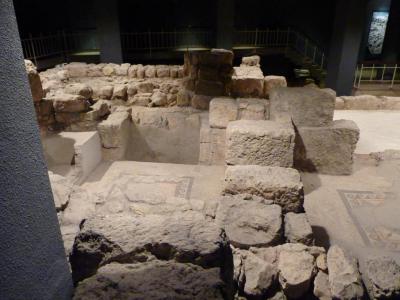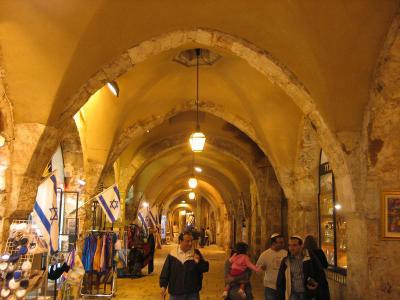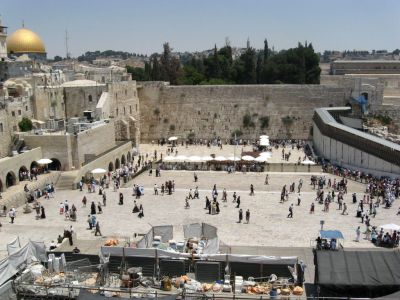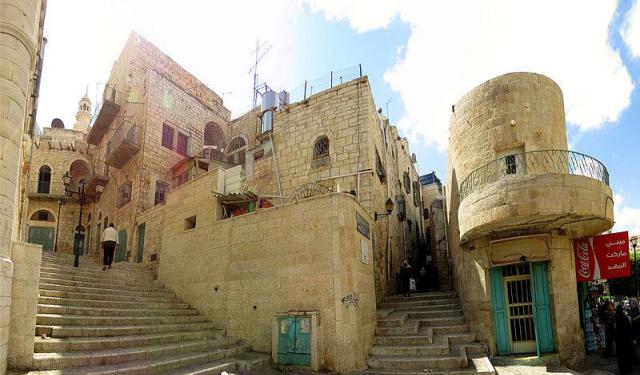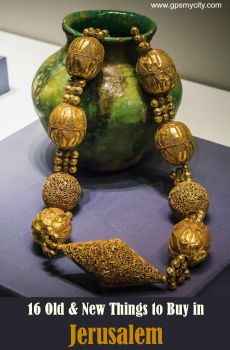Jewish Quarter Walking Tour (Self Guided), Jerusalem
Entirely rebuilt in the 1980s after having been largely destroyed during the 1948 War, the Jewish Quarter is quite distinct from the rest of the Old City. Good signposting, spacious passageways, art galleries and a somewhat less buzzing atmosphere make the area a relaxing place to spend some time.
With its rebuilt residential buildings, some almost consider this area the "New Jerusalem"; however, while here, one is surrounded by religious, archaeological, cultural and historical sites, any one of which one could spend hours or even days at.
While, arguably, the quarter’s most impressive synagogue is the thrice-rebuilt Hurva, two of the four Sephardic synagogues date back even further to the early 17th century. These all contain much ornate decoration and are so close together that as you leave one, the same door takes you directly into the next. Rather curiously as well, the adjacent Ramban Synagogue – 2nd-oldest of its kind in the Old City – is believed to have been built on Mount Zion and then moved there in the 14th century.
Also worth noting, today’s Old City streets still broadly follow the pattern laid down by the Romans, as proven by the Cardo – an excavated and partially reconstructed section of the main street of Byzantine-era Jerusalem. By booking a tour in advance, you can even explore a below-street-level tunnel dug by archaeologists under the Western Wall – Judaism’s holiest site, awaiting at the end of the itinerary.
Take this self-guided walk to explore the Jewish Quarter’s main points of interest, both above and below ground!
With its rebuilt residential buildings, some almost consider this area the "New Jerusalem"; however, while here, one is surrounded by religious, archaeological, cultural and historical sites, any one of which one could spend hours or even days at.
While, arguably, the quarter’s most impressive synagogue is the thrice-rebuilt Hurva, two of the four Sephardic synagogues date back even further to the early 17th century. These all contain much ornate decoration and are so close together that as you leave one, the same door takes you directly into the next. Rather curiously as well, the adjacent Ramban Synagogue – 2nd-oldest of its kind in the Old City – is believed to have been built on Mount Zion and then moved there in the 14th century.
Also worth noting, today’s Old City streets still broadly follow the pattern laid down by the Romans, as proven by the Cardo – an excavated and partially reconstructed section of the main street of Byzantine-era Jerusalem. By booking a tour in advance, you can even explore a below-street-level tunnel dug by archaeologists under the Western Wall – Judaism’s holiest site, awaiting at the end of the itinerary.
Take this self-guided walk to explore the Jewish Quarter’s main points of interest, both above and below ground!
How it works: Download the app "GPSmyCity: Walks in 1K+ Cities" from Apple App Store or Google Play Store to your mobile phone or tablet. The app turns your mobile device into a personal tour guide and its built-in GPS navigation functions guide you from one tour stop to next. The app works offline, so no data plan is needed when traveling abroad.
Jewish Quarter Walking Tour Map
Guide Name: Jewish Quarter Walking Tour
Guide Location: Israel » Jerusalem (See other walking tours in Jerusalem)
Guide Type: Self-guided Walking Tour (Sightseeing)
# of Attractions: 7
Tour Duration: 1 Hour(s)
Travel Distance: 1.3 Km or 0.8 Miles
Author: vickyc
Sight(s) Featured in This Guide:
Guide Location: Israel » Jerusalem (See other walking tours in Jerusalem)
Guide Type: Self-guided Walking Tour (Sightseeing)
# of Attractions: 7
Tour Duration: 1 Hour(s)
Travel Distance: 1.3 Km or 0.8 Miles
Author: vickyc
Sight(s) Featured in This Guide:
- Zion Gate
- Four Sephardic Synagogues
- Ramban Synagogue
- Hurva Synagogue
- Wohl Archaeological Museum
- Cardo Maximus
- Western (Wailing) Wall
1) Zion Gate
Lying among the eight gates embedded within the Old City's fortifications, the Zion Gate, also known as David's Gate, serves as a direct passage into the Armenian and Jewish Quarters. If the tales of the famous Jewish king's burial here hold true, the name couldn't be more fitting. With its angular features crafted to thwart invaders, one can now traverse it in the opposite direction and 'invade' the Old City at any hour of the day. Besides, the walls along here are especially nice, offering splendid photo opportunities under the afternoon sun.
Constructed by engineers of Suleiman the Magnificent around 1540, this gate facilitated direct access from the city to the sacred sites atop Mount Zion. In the 19th century, the nearby vicinity gained notoriety as a gathering point for lepers. The battleground was particularly intense here in 1948, as Israeli soldiers struggled to breach the walls to relieve the besieged Jewish Quarter held by the Jordanians. Today, the gate's exterior bears witness to the ferocious combat, marred by numerous bullet holes. A short distance to the west, conspicuous damage to the base of the wall remains from the soldiers' attempts to blast their way through with explosives.
Constructed by engineers of Suleiman the Magnificent around 1540, this gate facilitated direct access from the city to the sacred sites atop Mount Zion. In the 19th century, the nearby vicinity gained notoriety as a gathering point for lepers. The battleground was particularly intense here in 1948, as Israeli soldiers struggled to breach the walls to relieve the besieged Jewish Quarter held by the Jordanians. Today, the gate's exterior bears witness to the ferocious combat, marred by numerous bullet holes. A short distance to the west, conspicuous damage to the base of the wall remains from the soldiers' attempts to blast their way through with explosives.
2) Four Sephardic Synagogues
This cluster of small interconnected synagogues, once the spiritual hub of Jerusalem’s Sephardic community dating back to the 17th century, has been recently restored to its former glory. The exquisite furniture and intricate designs, sourced from similar synagogues-including those in Italy whose congregations had migrated to Israel- stand as a testament to a bygone era.
Constructed to comply with Ottoman regulations dictating that non-Muslim prayer houses couldn't surpass neighboring mosques in height, these synagogues ingeniously positioned their ground floors below street level. During Israel's War of Independence, they provided sanctuary to the Jews of the Old City's Jewish Quarter.
However, when the Old City fell to the Jordanian Legion, the synagogues were destroyed and the area repurposed as livestock stalls. Following the Six-Day War in 1967, concerted efforts by Jewish organizations worldwide and the Israeli government led to their restoration, with poignant images documenting their transformation from ruin to resurrection.
For those intrigued by synagogues and Sephardic Judaism, this is an essential visit. The rich history and tranquil ambiance, coupled with minimal tourist crowds, make it a truly special place on the outskirts of the Jewish Quarter.
Constructed to comply with Ottoman regulations dictating that non-Muslim prayer houses couldn't surpass neighboring mosques in height, these synagogues ingeniously positioned their ground floors below street level. During Israel's War of Independence, they provided sanctuary to the Jews of the Old City's Jewish Quarter.
However, when the Old City fell to the Jordanian Legion, the synagogues were destroyed and the area repurposed as livestock stalls. Following the Six-Day War in 1967, concerted efforts by Jewish organizations worldwide and the Israeli government led to their restoration, with poignant images documenting their transformation from ruin to resurrection.
For those intrigued by synagogues and Sephardic Judaism, this is an essential visit. The rich history and tranquil ambiance, coupled with minimal tourist crowds, make it a truly special place on the outskirts of the Jewish Quarter.
3) Ramban Synagogue
When the Spanish rabbi and scholar Moses Ben Nahman (Nahmanides) sought refuge in Jerusalem in 1267, he was dismayed to find only two Jewish families remaining. The Crusaders had slaughtered the city's Jews in 1099 and barred others from returning. Determined to revive the community's life, Nahmanides acquired land near King David’s Tomb on Mount Zion and established a synagogue, which eventually became a hub for Talmudic study, attracting scholars from far and wide.
Upon the rabbi's passing around 1400, the synagogue was rebuilt at the new location, albeit below ground level, so as to comply with regulations that forbade structures taller than mosques. It quickly emerged as the focal point of Jewish life in Mamluk Jerusalem, marking a significant return of Jews to this part of the Old City since their expulsion in AD 135.
The structure underwent reconstruction in 1523 after its collapse, becoming perhaps the sole Jewish place of worship in Ottoman-controlled Jerusalem. However, in 1587, Jewish worship was banned by authorities, and the building was repurposed as a workshop. It wasn't until 1967, when Israel reclaimed the Old City from Jordan, that Ramban was restored for worship, seven centuries after its original renovation, becoming the oldest standing synagogue in the city.
To enter, pass through the stone gateway and descend the steps. Remember to dress modestly (no tank tops or revealing attire) and cover your head if you're a man; also, refrain from photography or cell phone use on Shabbat. Entry is free!
Upon the rabbi's passing around 1400, the synagogue was rebuilt at the new location, albeit below ground level, so as to comply with regulations that forbade structures taller than mosques. It quickly emerged as the focal point of Jewish life in Mamluk Jerusalem, marking a significant return of Jews to this part of the Old City since their expulsion in AD 135.
The structure underwent reconstruction in 1523 after its collapse, becoming perhaps the sole Jewish place of worship in Ottoman-controlled Jerusalem. However, in 1587, Jewish worship was banned by authorities, and the building was repurposed as a workshop. It wasn't until 1967, when Israel reclaimed the Old City from Jordan, that Ramban was restored for worship, seven centuries after its original renovation, becoming the oldest standing synagogue in the city.
To enter, pass through the stone gateway and descend the steps. Remember to dress modestly (no tank tops or revealing attire) and cover your head if you're a man; also, refrain from photography or cell phone use on Shabbat. Entry is free!
4) Hurva Synagogue
The Hurva Synagogue stands as a testament to the resilience of Jerusalem's Jewish community, having been erected and razed three times over its 300-year existence. Even its name, meaning "ruins" in Hebrew, speaks to its tumultuous history, yet like a phoenix, it has repeatedly risen from its ashes. After being demolished by Jordan’s Arab Legion in 1948, it was faithfully restored to its 19th-century Neo-Byzantine style and re-dedicated in 2010. While modern building techniques may differ (the original was certainly not predominantly concrete as the new structure is), the new Hurva closely resembles its predecessor, adding a striking third dome to Jerusalem's skyline alongside the Dome of the Rock and the Holy Sepulchre. Inside, its decor is elegant yet restrained, avoiding excessive ornamentation.
Daily use sees believers on the ground floor engaged in Torah study or computer work (apparently the norm), though participation is limited to Jews only. For a fee, non-Jewish visitors can access a lift to a walkway encircling the dome, offering views of the synagogue's interior, including its monumental ark and stained glass windows, as well as remnants of the 19th-century ruins incorporated into the current structure. The footbridge also leads to an outdoor gazebo providing picturesque vistas of the Jewish Quarter, the minaret of the nearby Mosque of Omar, and the lively plaza in front of the synagogue – a hub of social activity.
Tips:
Access the entrance at the rear, on HaYehudim Street, tucked away from plain sight.
Consider using the informative audio guide for a comprehensive tour of the building.
Daily use sees believers on the ground floor engaged in Torah study or computer work (apparently the norm), though participation is limited to Jews only. For a fee, non-Jewish visitors can access a lift to a walkway encircling the dome, offering views of the synagogue's interior, including its monumental ark and stained glass windows, as well as remnants of the 19th-century ruins incorporated into the current structure. The footbridge also leads to an outdoor gazebo providing picturesque vistas of the Jewish Quarter, the minaret of the nearby Mosque of Omar, and the lively plaza in front of the synagogue – a hub of social activity.
Tips:
Access the entrance at the rear, on HaYehudim Street, tucked away from plain sight.
Consider using the informative audio guide for a comprehensive tour of the building.
5) Wohl Archaeological Museum
An impressive archaeological site within the Jewish Quarter, the Wohl Museum offers a captivating look into the remnants–some very well preserved and all well presented–of six priests' mansions in an Upper City neighborhood ravaged by the Romans during the Jewish Rebellion of 70 AD. At a time when Jerusalem was enjoying rising prosperity, this enclave–inhabited by affluent, aristocratic and priestly families–became one of the most desired living locations. The remains alone give one a good suggestion of the opulence of these structures in their glory days, as well as a general perception of the art, culture, and day-to-day lives of the city's elite.
Descending from street level, visitors can stroll on platforms above and within the excavation area, supported by informative brochures, wall maps, and displays that provide context to the artifacts unearthed. Among the discoveries are mosaic-tiled floors, fragments of frescoed walls, intricately carved stone furniture, and numerous ritual baths. Each house featured an inner patio and cisterns to collect rainwater, the primary water source at the time; as for the thick layer of ash blanketing the site, it is undoubtedly a mark of the devastating devastation caused by the Romans.
Suitable for families, lovers of history in general and of the Jewish people in particular; also a good way to stay cool on a hot day!
Tip:
Admission also grants access to the excavations at the Burnt House, enriching the visitor's experience.
Descending from street level, visitors can stroll on platforms above and within the excavation area, supported by informative brochures, wall maps, and displays that provide context to the artifacts unearthed. Among the discoveries are mosaic-tiled floors, fragments of frescoed walls, intricately carved stone furniture, and numerous ritual baths. Each house featured an inner patio and cisterns to collect rainwater, the primary water source at the time; as for the thick layer of ash blanketing the site, it is undoubtedly a mark of the devastating devastation caused by the Romans.
Suitable for families, lovers of history in general and of the Jewish people in particular; also a good way to stay cool on a hot day!
Tip:
Admission also grants access to the excavations at the Burnt House, enriching the visitor's experience.
6) Cardo Maximus
One of the Jewish Quarter's most evocative sites is the Cardo Maximus, the broad, column-lined main street of Hadrian's ancient city, Aelia Capitolina. This particular segment is actually a Byzantine addition to the original Roman Cardo, which stretched from the Damascus Gate (now in the Muslim Quarter) down through what is now the Souq Khan al-Zeit. Once the city's main artery and later the bustling market of the Crusaders, the Cardo now lies between two modern roads, Habad Street and Jewish Quarter Road, at a lower level.
Strolling along the Byzantine pavement flanked by elegant colonnades, one can easily envision the activity of its ancient past. The vaulted northern end of the excavated section now houses upscale gift shops, art galleries, along with remnants of the Hasmonean city wall and structures from the First Temple period. Additionally, you'll find charming pizza parlors and cafes perfect for a quick bite, though it's wise to exercise caution in the evenings, as locals may not appreciate tourists wandering the neighborhood streets and alleys.
Tip:
Be sure to visit Chaya, a store renowned for its exquisite collection of Judaica, jewelry, and gifts, offering reasonable prices and exceptional customer service.
Strolling along the Byzantine pavement flanked by elegant colonnades, one can easily envision the activity of its ancient past. The vaulted northern end of the excavated section now houses upscale gift shops, art galleries, along with remnants of the Hasmonean city wall and structures from the First Temple period. Additionally, you'll find charming pizza parlors and cafes perfect for a quick bite, though it's wise to exercise caution in the evenings, as locals may not appreciate tourists wandering the neighborhood streets and alleys.
Tip:
Be sure to visit Chaya, a store renowned for its exquisite collection of Judaica, jewelry, and gifts, offering reasonable prices and exceptional customer service.
7) Western (Wailing) Wall (must see)
The Western Wall – otherwise known as the Wailing Wall, the Place of Weeping, or the Buraq Wall – is part of the last remaining wall of the Temple Mount in Old Jerusalem, and was built in 19 BCE by Herod the Great. The king expanded the Temple Mount area artificially and had the wall built to retain the soil and filler added during that period.
The wall stands about 100 feet high from its foundation, of which only approximately 60 feet are showing above ground. Out of total 45 stone courses laid, only 28 are visible. The first seven layers are dating from the time of Herod the Great, four more layers were added by the Umayyad Caliphate – around 600 CE, and another 14 during the Ottoman period in the 1860s. Finally, the last three layers were added by the Mufti of Jerusalem in the 1920s. No further additions have occurred since the Six-Day War of 1967.
The size of the stones used in the construction is enormous, some weighing between two and eight tons, and one huge stone near Wilson’s Arch weighing alone a staggering 570 tons!!! The amount of effort put into the project of such magnitude is hard to overestimate.
The Wailing Wall has been the site of Jewish pilgrimage and prayer since at least the 300s CE, and is considered to be one of the holiest places for Jews because of its proximity to the Temple Mount. The name “wailing” derives from the Jewish practice of mourning the loss of the Holy Temple on the Temple Mount. The plaza in front of the wall was built after the Six-Day War as a gathering place for worshipers.
Both men and women are allowed to pray at the wall, although they must use separate entrances. The wall is particularly busy at Sabbath which commences at sundown on Friday and lasts until sundown on Saturday. It has now become a tradition to bring to the wall a prayer request written on a small slip of paper to be stuck between the stones. These papers are removed once a month and taken to the Mount of Olives.
Tip:
When visiting, make sure to bring along a valid ID (passport); expect tight security, and dress modestly.
No pictures are allowed during the Sabbath. The entry is free.
The wall stands about 100 feet high from its foundation, of which only approximately 60 feet are showing above ground. Out of total 45 stone courses laid, only 28 are visible. The first seven layers are dating from the time of Herod the Great, four more layers were added by the Umayyad Caliphate – around 600 CE, and another 14 during the Ottoman period in the 1860s. Finally, the last three layers were added by the Mufti of Jerusalem in the 1920s. No further additions have occurred since the Six-Day War of 1967.
The size of the stones used in the construction is enormous, some weighing between two and eight tons, and one huge stone near Wilson’s Arch weighing alone a staggering 570 tons!!! The amount of effort put into the project of such magnitude is hard to overestimate.
The Wailing Wall has been the site of Jewish pilgrimage and prayer since at least the 300s CE, and is considered to be one of the holiest places for Jews because of its proximity to the Temple Mount. The name “wailing” derives from the Jewish practice of mourning the loss of the Holy Temple on the Temple Mount. The plaza in front of the wall was built after the Six-Day War as a gathering place for worshipers.
Both men and women are allowed to pray at the wall, although they must use separate entrances. The wall is particularly busy at Sabbath which commences at sundown on Friday and lasts until sundown on Saturday. It has now become a tradition to bring to the wall a prayer request written on a small slip of paper to be stuck between the stones. These papers are removed once a month and taken to the Mount of Olives.
Tip:
When visiting, make sure to bring along a valid ID (passport); expect tight security, and dress modestly.
No pictures are allowed during the Sabbath. The entry is free.
Walking Tours in Jerusalem, Israel
Create Your Own Walk in Jerusalem
Creating your own self-guided walk in Jerusalem is easy and fun. Choose the city attractions that you want to see and a walk route map will be created just for you. You can even set your hotel as the start point of the walk.
Muslim Quarter & Temple Mount Tour
The largest, most populous and perhaps most chaotic of all Jerusalem’s quarters, the Muslim Quarter is worth exploring for its unique atmosphere. Spending a day here may take you back to a simpler time, but be prepared for many sights and sounds as you pass many vendors, stores and restaurants on your way from site to site.
Some of the city’s most interesting city gates (Damascus and... view more
Tour Duration: 2 Hour(s)
Travel Distance: 2.1 Km or 1.3 Miles
Some of the city’s most interesting city gates (Damascus and... view more
Tour Duration: 2 Hour(s)
Travel Distance: 2.1 Km or 1.3 Miles
Jerusalem Old City Walking Tour
A UNESCO World Heritage Site since 1981, the Old City of Jerusalem is best explored on foot, since its narrow streets and alleys make it almost an entirely vehicle-free zone. In addition to hosting four ethnic quarters, – Jewish, Muslim, Christian and Armenian – it is packed with major historical and religious sites, which all make a trip here unique, unforgettable and not to be missed.
The... view more
Tour Duration: 3 Hour(s)
Travel Distance: 5.0 Km or 3.1 Miles
The... view more
Tour Duration: 3 Hour(s)
Travel Distance: 5.0 Km or 3.1 Miles
Mount Scopus Walking Tour
Dotted with many sightseeing places, Mount Scopus – translating as the “Observation Mount” from Greek – is a great place to get views over the whole Old City of Jerusalem on a nice day. The mount has been of major strategic importance since Roman times, with forces setting up camp here prior to laying the siege that culminated in the final Roman victory over Jerusalem around 70 AD.... view more
Tour Duration: 1 Hour(s)
Travel Distance: 2.3 Km or 1.4 Miles
Tour Duration: 1 Hour(s)
Travel Distance: 2.3 Km or 1.4 Miles
Bethlehem Walking Tour
Perched on a hill at the edge of the Judaean Desert, Bethlehem has been known to the world, for more than two millennia, as the birthplace of Jesus Christ. The “star of Bethlehem” as well as Christmas carols and hymns are firmly associated with this ancient city in the West Bank, Palestine, and thus, for some visitors, the bustle of a modern city may come as a surprise.
Undoubtedly, the... view more
Tour Duration: 1 Hour(s)
Travel Distance: 1.5 Km or 0.9 Miles
Undoubtedly, the... view more
Tour Duration: 1 Hour(s)
Travel Distance: 1.5 Km or 0.9 Miles
Mount of Olives Walking Tour
Aside from affording great views over the Old City, the Mount of Olives is home to half a dozen major sites of the Christian faith along with the oldest Jewish burial ground in the world. Considered a holy spot by many, it is associated with numerous events in Jesus’ life including ascending to Heaven and teaching his disciples the Lord’s Prayer.
The following self-guided walking tour will... view more
Tour Duration: 1 Hour(s)
Travel Distance: 1.7 Km or 1.1 Miles
The following self-guided walking tour will... view more
Tour Duration: 1 Hour(s)
Travel Distance: 1.7 Km or 1.1 Miles
Jerusalem City Gates Walking Tour
Historians believe that the Old City of Jerusalem probably came into being more than 4,500 years ago. The defensive wall around it features a number of gates built on the order of the Ottoman sultan Suleyman the Magnificent in the first half of the 16th century, each of which is an attraction in its own right. Until as recently as 1870, they were all closed from sunset to sunrise; nowadays, just... view more
Tour Duration: 2 Hour(s)
Travel Distance: 3.7 Km or 2.3 Miles
Tour Duration: 2 Hour(s)
Travel Distance: 3.7 Km or 2.3 Miles
Useful Travel Guides for Planning Your Trip
16 Uniquely Israel Things to Buy in Jerusalem
Modern day Jerusalem is a mosaic of neighborhoods, reflecting different historical periods, cultures, and religions. The influx of repatriates in recent years has made the cultural and artisanal scene of the city even more colourful and diverse. To find your way through Jerusalem's intricate...
The Most Popular Cities
/ view all
